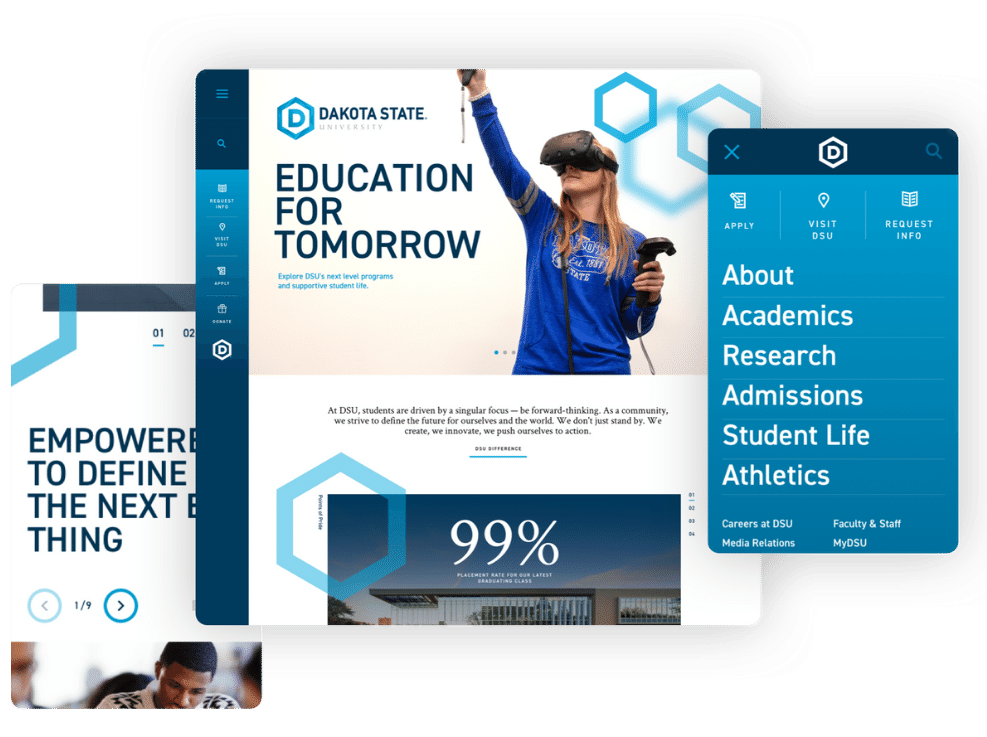Unlocking the Keys to Extraordinary Web Design for Your Business
The Comprehensive Overview to Crafting Aesthetically Appealing and Practical Website Design That Fulfills User Needs
In today's electronic landscape, the significance of crafting website design that are both visually enticing and practical can not be overemphasized. By focusing on user-centered layout concepts, designers can develop experiences that not only attract however likewise keep user interest. Key visual elements such as balance, alignment, and contrast play a critical function in this procedure, while the requirement of receptive design makes certain ease of access throughout numerous tools. Nonetheless, the trip does not end with first style; ongoing screening and version are important for refinement. What methods can one use to effectively stabilize these elements?
Recognizing User-Centered Design
At the heart of efficient web style lies the concept of user-centered layout, a philosophy that focuses on the demands, choices, and actions of users throughout the development procedure. This strategy entails thorough research study to understand the target audience, guaranteeing that the end product resonates with its designated users. By incorporating user responses at every stage, designers can develop interfaces that are not just visually attractive but additionally practical and user-friendly.
User-centered layout emphasizes compassion, needing designers to tip into the users' footwear and consider their point of views. Methods such as user identities, journey mapping, and use screening are utilized to determine pain points and opportunities for improvement. This iterative process permits continuous refinement, as designers adjust to advancing user demands and technological innovations.
Incorporating user-centered design causes boosted individual complete satisfaction and engagement, inevitably resulting in higher conversion prices and brand commitment. It fosters a collective atmosphere where stakeholders, consisting of designers, users, and programmers, interact to attain a shared vision. By putting customers at the leading edge of the layout process, companies can create internet sites that not just fulfill service objectives yet also provide significant and gratifying experiences for users.
Trick Principles of Visual Style
Efficient aesthetic style acts as the structure for developing appealing and user-friendly web sites. It encompasses a number of essential concepts that assist developers in crafting aesthetically pleasing and useful interfaces.
First, balance plays a vital function in achieving visual consistency. Designers ought to distribute elements equally across the layout to avoid overwhelming users. This can be attained with in proportion or asymmetrical design strategies.

In addition, positioning is vital for arranging info. Regular alignment of text and pictures promotes a tidy layout, boosting general navigation and user experience.
 Closeness likewise adds to aesthetic quality. Organizing relevant things together aids users in understanding the relationship in between various components, making the user interface a lot more user-friendly.
Closeness likewise adds to aesthetic quality. Organizing relevant things together aids users in understanding the relationship in between various components, making the user interface a lot more user-friendly.Lastly, uniformity in design elements, such as styles, shades, and font styles, strengthens brand identity and aids customers navigate the site extra effortlessly. By incorporating these vital concepts of visual layout, web designers can develop interfaces that are not just aesthetically enticing yet user-centered and also functional.

Value of Responsive Design
Receptive style is an essential element of modern-day internet advancement, making sure that sites work flawlessly throughout a variety of tools and screen sizes. As the net landscape develops, the variety of devicesâEUR" varying from smart devices to tablet computers and desktop computersâEUR" necessitates a style method that suits all customers.
Implementing responsive style enables a versatile design that immediately adapts based on the customer's display measurements. This flexibility not just improves availability but likewise enhances use, as users can browse and interact with the website effortlessly, no matter their gadget.
Furthermore, search engines like Google focus on mobile-friendly internet sites in their ranking formulas. A responsive design can considerably improve a website's search engine optimization efficiency, ultimately driving even more traffic and increasing presence.
Furthermore, responsive layout lowers the requirement for maintaining several variations of a site, streamlining updates and content monitoring. This effectiveness equates right into expense financial savings and review an extra cohesive brand experience across platforms.
Enhancing User Experience
User experience (UX) is a crucial element of internet layout, affecting just how visitors communicate with a web site and regard its value. A well-crafted UX makes sure that users can browse with ease, locate information easily, and attain their goals efficiently. The style should consider the customer's journey, from the minute they arrive on the site to the conclusion of their wanted action, whether that be purchasing, registering for a newsletter, or accessing information.
Crucial element that boost UX include clear navigating, receptive layouts, and appealing visual web content. Uniformity in design elements such as buttons, typefaces, and colors cultivates familiarity, making the internet site feel cohesive. In addition, maximizing load times is crucial; users are less likely to click now remain on a site that is sluggish to respond.
Including ease of access features makes sure that all individuals, consisting of those with handicaps, can engage with the site seamlessly. Moreover, user-centric style principles must guide content company, supplying pertinent information in a rational structure. By focusing on customer needs and choices, web designers can produce experiences that are not only aesthetically appealing however additionally useful, ultimately fostering user fulfillment and loyalty
Checking and Repeating Layouts
Examining and repeating designs are fundamental procedures that comply with the preliminary creation of a site, ensuring that the user experience remains at the leading edge of any type of modifications. These phases entail gathering user responses, analyzing design efficiency, and making notified modifications to enhance usability and involvement.
Usability testing allows designers to observe real individuals as they connect with the internet site, identifying discomfort factors and areas for improvement (web design). User studies can offer qualitative insights, catching user beliefs and choices.
When screening is finished, the version stage begins. This involves refining the design based on the gathered information, focusing on modifications that straighten with user needs and service goals. Continuous version cultivates an adaptive style strategy, where the site progresses in feedback to customer actions and feedback. By dedicating to extensive testing and version, designers can create a web site that not just meets visual requirements yet additionally delivers a smooth and enjoyable individual experience.
Verdict
In final thought, reliable website design necessitates the assimilation of user-centered concepts, crucial visual style aspects, and responsive frameworks to produce engaging interfaces. By prioritizing user demands and implementing continuous screening and version, developers can improve their productions to improve general fulfillment. The dedication to these methods not just fosters a visually attractive visual yet additionally makes sure performance across varied tools, eventually adding to a favorable customer experience and raised engagement.
By focusing on user-centered layout concepts, designers can produce experiences that not just attract however additionally maintain individual interest.At the heart of reliable internet style exists the concept of user-centered layout, an approach that prioritizes the demands, preferences, and actions of customers throughout the growth process. By placing users at the center of the layout process, companies can create web sites that not just meet service purposes yet also offer rewarding and purposeful experiences for individuals.
By focusing on customer needs and choices, web developers can create experiences that are not only visually attractive but additionally functional, ultimately promoting customer contentment and read the full info here loyalty.
Individual surveys can provide qualitative insights, capturing individual beliefs and preferences. (web design)